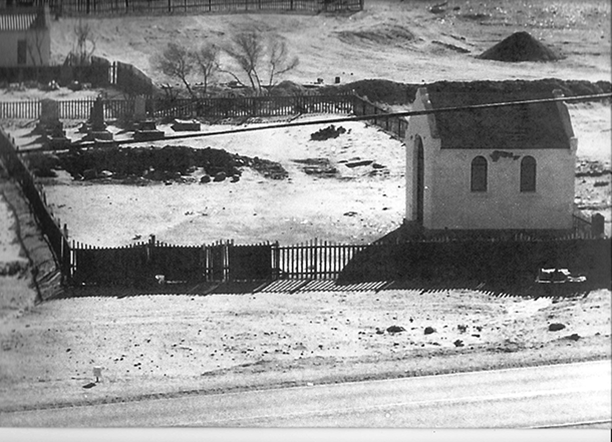 Exterior View (2005), 15” x 11” Photograph, Jay A. Waronker
Exterior View (2005), 15” x 11” Photograph, Jay A. Waronker
NAMIBIA
Jewish Cemetery Chapel (Dating to the Early |
The Jewish cemetery in Luderitz is located a few miles outside of town on the north side of the two-lane east-west B1 highway leading from Keetmanshoop. |
|
Luderitz, a harbor town located in southwestern Namibia, was founded in 1883 during the German colonial period. In 1909, after the discovery of diamonds nearby, Luderitz experienced a surge in population and prosperity that lasted until World War I and the capitulation of the colony to South Africa. During this period, Jews mostly of German origin and seeking opportunity arrived and settled in Luderitz. As a result, a sustainable community was established. The 1920s and 30s saw a decline in Ludertiz once the center of the diamond mining moved south and east into South Africa. This development led to the loss of Luderitz’s importance as a trade and commercial center, and this turn of events affected the Jewish community. Although the Jews had organized a congregation and prayed in private homes and temporary facilities for some decades, they never built a proper synagogue.
The Jewish cemetery in Luderitz is located a few miles outside of town on the north side of the two-lane east-west B1 highway leading from Keetmanshoop. The cemetery, serving the Christian community as well, includes a dedicated area for Jewish graves surrounded by a dilapidated wood picket fence. Within this area are nine graves positioned towards the northwest corner of the cemetery, seven that are inscribed in English and Hebrew while the two others are unmarked. About half the Jews buried here came from Germany and were born in the 1880s, and they died in the 1910s and 20s. Other deaths date some years later, to the 1940s and 50s. The most recent one grave indicates a date of death of 1988.
Once located at the southeast corner of the Jewish cemetery was a tiny funerary chapel built in the early 20th century. It featured Dutch gable ends, white washed plaster walls, a gray slate tiled roof, and entry door containing a rounded arch placed at the west elevation. The chapel served the community for decades, yet in recent years it was not maintained and became derelict. At some time in 2005 or early 2006, the chapel was demolished. According to the city engineer of Luderitz, the deteriorated building had become the refuge for vagrants and prostitute, and the decision was made by city officials without any attempt to reach out to the Namibian Jewish community to tear the historic structure down. Waronker arrived soon after the chapel had been demolished, and to document it he was provided by the city engineer a photograph of it taken not long before it met its unfortunate demise.
